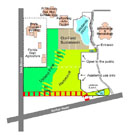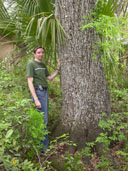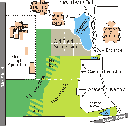 |
Fig. 1. Map of NATL showing the right-of-way of the proposed extension of SW 24th Avenue. (Click on thumbnail for a larger, annotated map.) |
 |
Fig. 2. The largest (29 inches DBH) of at least 10 hickories with trunk diameters of 22 inches or more that would be bulldozed to clear the road right-of-way. Numerous large trees of other species are also in the right-of-way (e.g., live oaks, max. 29 inches; longleaf pines, max 24 inches; and sweet gums, max. 29 inches, if you omit a 42-inch giant that reduces to 27 inches at 7 ft up). |
 |
Fig. 4. A sinkhole just east of Regency Oaks Apartments is the lowest point in the karst basin outlined in orange. After even minor storms it overflows onto the right-of-way of the proposed extension. (Click on the thumbnail for more information.) |
 |
Fig. 5. Map of NATL showing its principal ecosystems and the division between public and academic areas. |